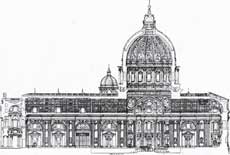St. Peter's Interior
It is the interior of St.Peter's Basilica which chiefly concerns us in considering the work of this period. The internal ordinance, with its gigantic pilasters and protruding impost moldings, is probably due to Bramante, and his assistants Peruzzi and Antonio Sangallo. Although the long arm of the cross, and its colossal wagon vault, is partly the addition of Maderna, the original idea is fairly well preserved, but with late and debased details and ornaments.

St. Peter's Basilica
Longitudinal Section
St. Peter's Basilica and the Vatican make up the one group of Renaissance architecture buildings which in scale and monumental character more than holds its own with the old Roman work. In this there is significant testimony to the truthfulness of architecture as the stone book of history. St. Peter's suggests the importance of the Church in the world of the 16th Century, the character of its rulers, as well as the spirit and aims of the constructors of the material fabric.
The architect will observe that Maderna's addition to Saint Peter's, in its design, its vaulting and lighting, as well as its dimensions, presents a close analogy with the Roman vaulted chamber of the Baths of Caracalla or Diocletian. Round about the dome, the part which belongs to the culminating period, there is little which need recall the old Roman models.
The Greek cross plan which successive architects schemed, is founded on the early churches, while Michelangelo's dome design is at the end of a chain in which the links are the dome of Santa Sophia and Santa Maria del Fiore. But for the principle illustrated by the Italian Byzantine domes, it would have been impossible to have "hung the Pantheon in heaven," and but for Brunelleschi's intrepid construction at Florence, even the hand of Michelangelo must have faltered before the boldness of its drum design with the poor abutment of the sixteen twin column props.
The triumph of "the hand that rounded Saint Peter's dome" consists largely in this, that on a scale which increases every difficulty out of all proportion, the union of both systems was successfully effected; so successfully that with the Pantheon and Santa Sophia the dome of Saint Peter's is one of the most nobly beautiful of architectural creations.
Interior effect of St. Peter's Basilica
The internal effect of Saint Peter's Basilica is a subject about which much has been said. All agreed that the impression it makes on a first visit is not so overwhelming as might be expected from its prodigious dimensions. Byron, in notable verse, has expressed the idea and given a poetic cause for the absence of this effect, and Nathaniel Hawthorne, in his delightful picture of Modern Rome, treats of the subject at some length.
The explanation may be, as he suggests, that when first one enters, the ghostly image which almost unconsciously had been cherished is shattered by the shock of the reality presented. When, for the first time, you stand below the dome, the first impression is of cheerfulness and color, should you chance to see it with the sunlight streaming through the clear windows on the mosaics and colored marbles, fresh and bright through five centuries.
Never before were classical orders of this size used, save in such monumental columns as those of Traian and Marcus Aurelius. But every moment of time spent within Saint Peter's Basilica and every fresh visit increases the sense of its immensity, until, to quote Hawthorne "after looking many times, with long intervals between, you discover that the Cathedral has gradually extended itself over the whole compass of your idea; it covers all the site of your visionary temple, and has room for its cloudy pinnacles beneath the dome."
The order of the outer wall is still higher, about ninety-four feet, and nine feet broad, the capitals being ten feet deep. The height of the wall surrounding the structure is 165 feet, while the figures on the balustrade of the east front are nineteen feet high.
While on this matter, it may be said that the total height of Saint Peter's at the dome is 435 feet, twice the height of the central towers of York or Durham Cathedrals; and although less remarkable for length than for width and height, it is longer than Rochester and Glasgow Cathedrals placed end to end. The ultimate victory of the Latin cross has deprived all spectators within a quarter of a mile to the east of their view of the dome. To see it close at hand we must go round the flank of the building, whence the effect is splendid, as it is also from any distant point of view.
The brackets designed by Michelangelo to unite the coupled columns and entablature with the attic were never carried out, and do not seem to be required.
Closely connected with the tendency to classic imitation may be considered the revival of Greek methods and preference for rectangular compositions, and continuity of lines. At St. Peter's, the moldings are refined, delicate, and yet vigorous. Instead of being cut out of a beveled surface like most of the early Renaissance cornices and moldings, they approach the wider sections of the Romans, but in refinement of line they are more often Greek in feeling than Roman. Projection is much increased, and all the effect of timidity induced by such low relief as Alberti's and Bramante's early work disappears.
The interior of St. Peter's Basilica was decorated by famous artists, among the most important works being Michelangelo's Pieta. Visiting Saint Peter's is a vibrant experience, comparable to seeing that extreme example of the Sistine Chapel, in the Apostolic Palace, the work of various artists, including Botticelli and Perugino, remarkable chiefly for the ceiling by Michelangelo, and the vast composition on the altar wall representing the Last Judgment, painted thirty years later by the same master hand.
St.Peter's Basilica - The beginning of the works.